
Os anos van pasando mais a fascinación dos filmes silentes continúa intacta tanto pra melenudos coma pra os aristócratas xermánicos e probabelmente nen revolucións proletárias, gordas herdeiras xermánicas, criados reivindicativos ou a chegada dun novo ano teutón, poderán pór en perigo a vixencia desas magníficas obras mestras dos nosos devanceiros.
Que vostedes continúen a desfrutalas perante o ano 2007 tendo sempre en conta a humidade do Schloss…
E agora se mo permiten teño que deixalos momentáneamente, pois este Conde xermánico ten que asistir ó baile de Aninovo a celebrar na embaixada Prusiana e na compaña dunha rica herdeira magra, austriaca e abstémia…, dende logo, unha noite tola agarda a éste Herr Graf…
Herr Graf Ferdinand Von Galitzien










